
The Pros
- Powerhouse
- Takes excellent bokeh pictures
- Great sound
The Cons
- Battery not comparable to other flagships
- Still not stock
- Lacks wireless charging
The U12+, HTC’s latest flagship, sports top-of-the-line features that could crown it king among 2018 smartphones.
Unfortunately, it also has two major shortcomings.
This notchless smartphone features top of the line technical specifications and feels solid in the hand, but it lacks sufficient battery power and widespread Canadian availability.
I’ll note, however, that the handset I tested was a pre-production unit, which means my experience might have been a little less polished than with a production device.
Pre-production unit or not, and even with its couple of the flaws, I really enjoyed my time with the HTC U12+ overall. The phone has a firm and sturdy build quality, a premium camera setup and offers quick performance speeds.
While the HTC U12+ is the successor to the HTC U11+, that device never came to Canada. Due to this fact, I’ll mainly compare it to the U11 in this review.
HTC U12+
Samsung Galaxy S9+
HTC U11
Display
6.0-inch Super LCD6 display. 2880 x 1440 pixels, 18:9 aspect ratio
6.2-inch Super AMOLED display, 1440 x 2960 pixels, 18.5:9 aspect ratio
5.5-inch Super LCD5 display, 1440 x 2560 pixels, 16:9 aspect ratio
Processor
Snapdragon 845
Snapdragon 845 (Exynos 9810 in Europe and other regions)
Snapdragon 835
RAM
6GB of RAM
6GB of RAM
4GB of RAM
Storage
64GB, 128GB (expandable up to 2TB)
64GB (expandable up to 400GB)
64GB, 128GB (expandable up to 256GB)
Dimensions (in.)
156.6 x 73.9 x 8.7mm
158.1 x 73.8 x 8.5mm
153.9 x 75.9 x 7.9mm
Weight
188g
189g
169g
Rear Facing Camera
12-megapixel (f/1.8) +16-megapixel (f/2.6, OIS, EIS)
12-megapixel (variable f/1.5 - f/2.4, OIS) + 12-megapixel (f.2.4, OIS) dual-LED flash
12-megapixel (f/1.7, OIS, AF) dual-LED flash
Front Facing Camera
8-megapixel (f/2.0) + 8-megapixel (f/2.0)
8-megapixel (f/1.7)
16-megapixel (f/2.0)
OS
Android 8.0 Oreo
Android 8.0 Oreo
Android 7.1
Battery
3,500mAh
3,500mAh
3,000mAh
Network Connectivity
GSM/HSPA/LTE
GSM/HSPA/LTE
GSM / HSPA / LTE
Sensors
Fingerprint (rear-mounted), accelerometer, Edge Sense 2.0, proximity sensor, magnetic sensor
Iris scanner, fingerprint (rear-mounted), Intelligent Scan, accelerometer, gyro, proximity, compass, barometer, heart rate, SpO2
Fingerprint Sensor, Gyro Sensor, Proximity Sensor, Edge Sensor, Sensor Hub, Motion G-senor, Compass sensor, Ambient light Sensor
SIM Type
Nano SIM
Nano SIM
Nano SIM,
Launch Date
May 23, 2018
March 16, 2018
May 16, 2017
Misc
Colours: Ceramic Black, Translucent Blue | IP68 certified, Face Unlock, Edge Sense 2.0,
Colours: Titanium Gray, Lilac Purple (in Canada) | IP68 water/dust resistant, wireless charging, USB, type C, Bluetooth 5.0
Colour: Brilliant Black, Sapphire Blue, Amazing Silver, Solar Red | Edge Sensor, IP67 water/dust resistant, USB Type-C, HTC Ultra Pixel 3 with 1.4μm pixel
Display
HTC U12+
6.0-inch Super LCD6 display. 2880 x 1440 pixels, 18:9 aspect ratio
Samsung Galaxy S9+
6.2-inch Super AMOLED display, 1440 x 2960 pixels, 18.5:9 aspect ratio
HTC U11
5.5-inch Super LCD5 display, 1440 x 2560 pixels, 16:9 aspect ratio
Processor
HTC U12+
Snapdragon 845
Samsung Galaxy S9+
Snapdragon 845 (Exynos 9810 in Europe and other regions)
HTC U11
Snapdragon 835
RAM
HTC U12+
6GB of RAM
Samsung Galaxy S9+
6GB of RAM
HTC U11
4GB of RAM
Storage
HTC U12+
64GB, 128GB (expandable up to 2TB)
Samsung Galaxy S9+
64GB (expandable up to 400GB)
HTC U11
64GB, 128GB (expandable up to 256GB)
Dimensions (in.)
HTC U12+
156.6 x 73.9 x 8.7mm
Samsung Galaxy S9+
158.1 x 73.8 x 8.5mm
HTC U11
153.9 x 75.9 x 7.9mm
Weight
HTC U12+
188g
Samsung Galaxy S9+
189g
HTC U11
169g
Rear Facing Camera
HTC U12+
12-megapixel (f/1.8) +16-megapixel (f/2.6, OIS, EIS)
Samsung Galaxy S9+
12-megapixel (variable f/1.5 - f/2.4, OIS) + 12-megapixel (f.2.4, OIS) dual-LED flash
HTC U11
12-megapixel (f/1.7, OIS, AF) dual-LED flash
Front Facing Camera
HTC U12+
8-megapixel (f/2.0) + 8-megapixel (f/2.0)
Samsung Galaxy S9+
8-megapixel (f/1.7)
HTC U11
16-megapixel (f/2.0)
OS
HTC U12+
Android 8.0 Oreo
Samsung Galaxy S9+
Android 8.0 Oreo
HTC U11
Android 7.1
Battery
HTC U12+
3,500mAh
Samsung Galaxy S9+
3,500mAh
HTC U11
3,000mAh
Network Connectivity
HTC U12+
GSM/HSPA/LTE
Samsung Galaxy S9+
GSM/HSPA/LTE
HTC U11
GSM / HSPA / LTE
Sensors
HTC U12+
Fingerprint (rear-mounted), accelerometer, Edge Sense 2.0, proximity sensor, magnetic sensor
Samsung Galaxy S9+
Iris scanner, fingerprint (rear-mounted), Intelligent Scan, accelerometer, gyro, proximity, compass, barometer, heart rate, SpO2
HTC U11
Fingerprint Sensor, Gyro Sensor, Proximity Sensor, Edge Sensor, Sensor Hub, Motion G-senor, Compass sensor, Ambient light Sensor
SIM Type
HTC U12+
Nano SIM
Samsung Galaxy S9+
Nano SIM
HTC U11
Nano SIM,
Launch Date
HTC U12+
May 23, 2018
Samsung Galaxy S9+
March 16, 2018
HTC U11
May 16, 2017
Misc
HTC U12+
Colours: Ceramic Black, Translucent Blue | IP68 certified, Face Unlock, Edge Sense 2.0,
Samsung Galaxy S9+
Colours: Titanium Gray, Lilac Purple (in Canada) | IP68 water/dust resistant, wireless charging, USB, type C, Bluetooth 5.0
HTC U11
Colour: Brilliant Black, Sapphire Blue, Amazing Silver, Solar Red | Edge Sensor, IP67 water/dust resistant, USB Type-C, HTC Ultra Pixel 3 with 1.4μm pixel
Lovely LCD6 Display
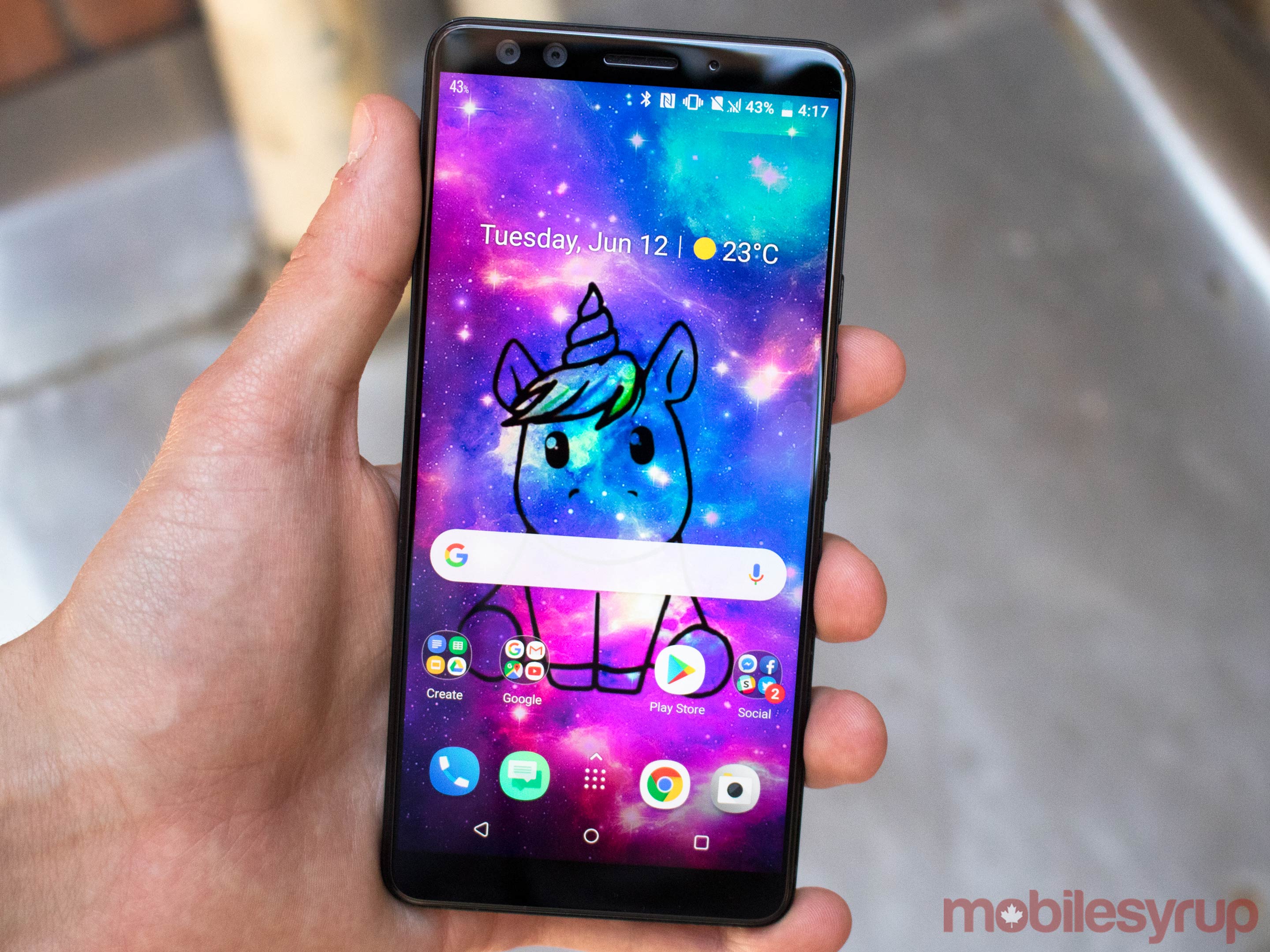
The HTC U12+ features a beautiful display that gets sufficiently bright in sunlight, measuring in at 406 nits, according to various publications. One should note that the iPhone X and the Samsung Galaxy S9 manage more than 800 nits of brightness, though. Nits of brightness can indicate how bright your screen can get.
Additionally, the display sports vivid colours. Highlights are sufficiently bright and blacks are also beautifully dark. The phone’s 1440 x 2880 pixel resolution display shows a clear picture, no matter what you’re looking at on-screen. Videos and images are also quite detailed; you can tell you’re never missing anything.
Unlike other phones I’ve used, such as the Samsung Galaxy S9 or the Huawei P20 Pro, I didn’t need to change the display settings when I first started the device. Out-of-the-box, the screen is stunning.
However, beauty is in the eye of the beholder and, unfortunately, you can’t customize the display very much. Specifically, users can’t make the display colder or warmer. The phone only features two colour profiles, DCI-P3 — which features a wide colour gamut — and sRBG which makes the smartphone slightly warmer as it uses a smaller range of colour.
HTC Liquid Surface
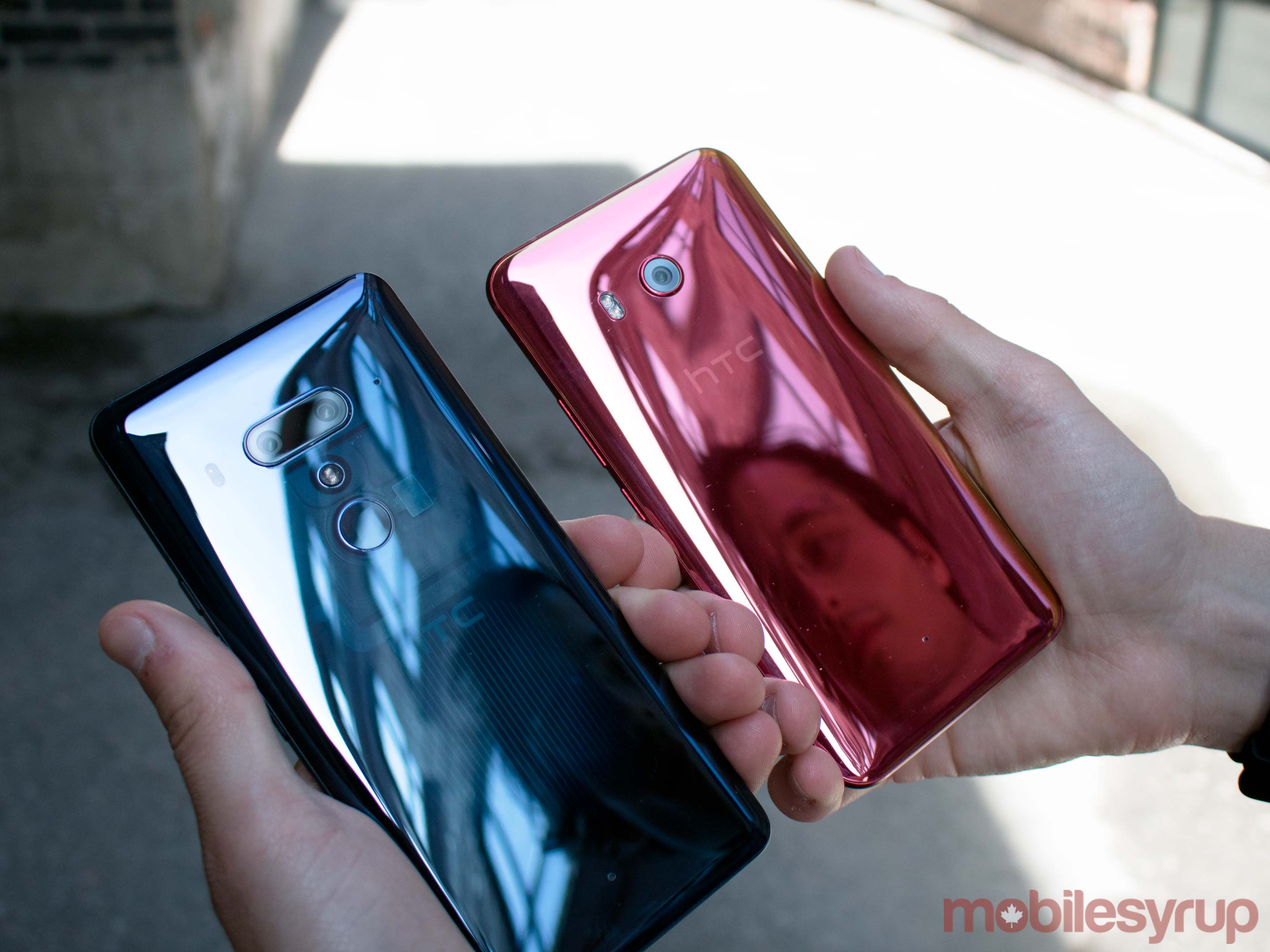
The HTC U12+ sports excellent design language and a premium feel.
When you first hold the phone, you can’t help but notice its thickness. While not the thickest flagship on the market — the Sony Xperia XZ2 takes the crown — it’s definitely thicker than the Huawei P20 Pro, LG G7 ThinQ, iPhone X, Samsung Galaxy S9+ and the OnePlus 6.
Other than the thickness, the phone’s bezels are a lot thinner than the U11’s, by a total of .39mm, which makes a large difference. The top bezel features a speaker with a dual camera setup to the left and a LED notification light to the right.
The rear of the phone is spectacular. HTC sent MobileSyrup the blue variant called simply ‘Translucent Blue.’ It features a transparent rear, which allows users to see the device’s internals. Other than the colour, the U12+ sports a rear-facing fingerprint sensor that’s easy to reach, a horizontal dual camera setup and a LED flash. The bottom of the smartphone features a USB Type-C charger and a downwards blasting speaker. What’s missing is a 3.5mm headphone jack.
The phone features Gorilla Glass 5 on the front and the back and hosts an aluminum frame. Unfortunately, even with the inclusion of a glass back, the phone lacks wireless charging.
Squeeze that phone
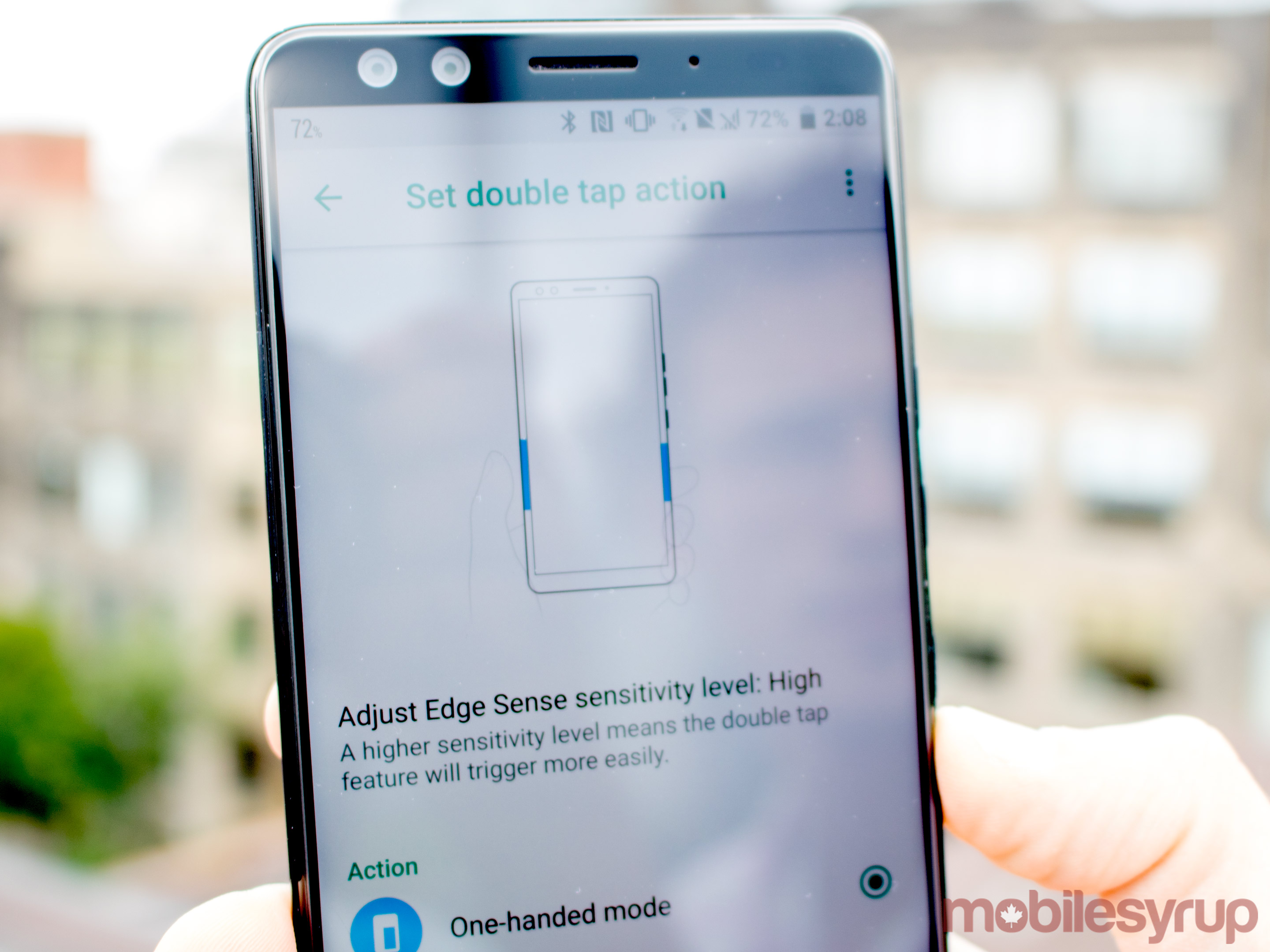
The HTC U12+ sports Edge Sense, a feature that allows users to squeeze the frame of the handset to launch apps and perform in-app actions. The feature was first introduced in last year’s HTC U11.
Users can also tap on the phone’s edges to use the U12+’s new pressure sensitive buttons. HTC has placed the U12+’s pressure sensitive button beneath the power button. There’s another one on the same location on the other side of the device.
I’ve also occasionally missed the buttons when trying to open the HTC launcher. Due to it being unclear exactly where the button is all the time simply because you can’t see it as it’s hidden within the frame. Similar to Edge Sense, users can set the new pressure sensitive buttons to open anything. It can also switch the device into one-handed mode for easier access to the full keyboard while typing.
Note: the power button and the volume rocker are not actual buttons, they work via the pressure sensitive frame. This definitely takes some getting used to and it didn’t always work, which is bothersome.
Powerhouse King
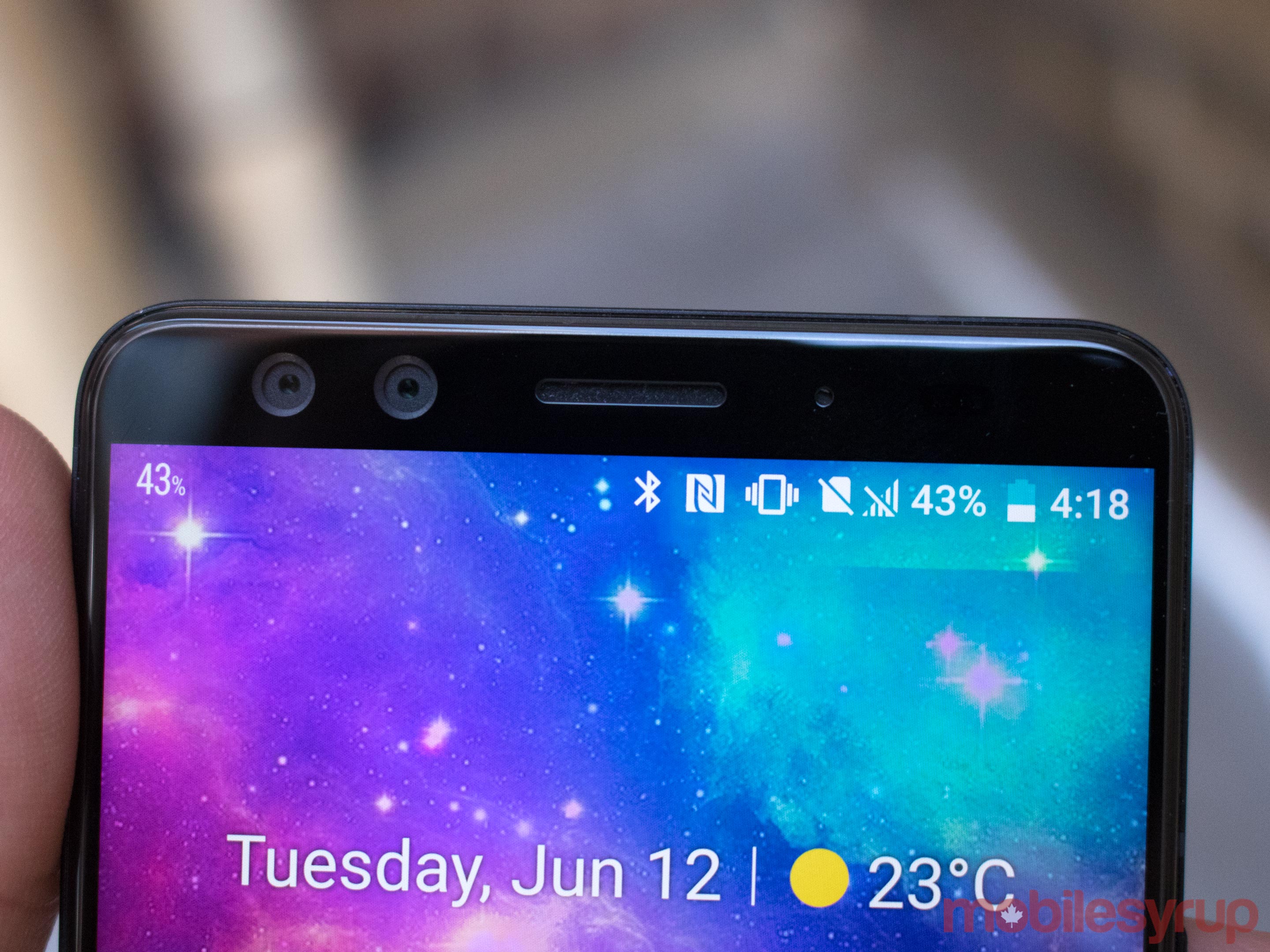
The HTC U12+ ran very smoothly and I never experienced any issues with the handset. Even after playing Paladin Strike, a multiplayer online battle arena (MOBA), or watching videos on Netflix, I didn’t experienced any issues.
With the same processor and the amount of RAM as the North American version of the Samsung Galaxy S9+, it makes sense that the U12+ is so fast and responsive.
Benchmark-wise, the HTC U12+ shows a score of 2,443 and a multi-core score of 8,876, which by far beats our recorded score for the Galaxy S9+. Our in-house Galaxy S9+ scored a single core score of 2,072 and a multi-core score of 8,357.
I used the Geekbench 4 app on the devices to determine benchmark speeds.
Sense UI is still not stock
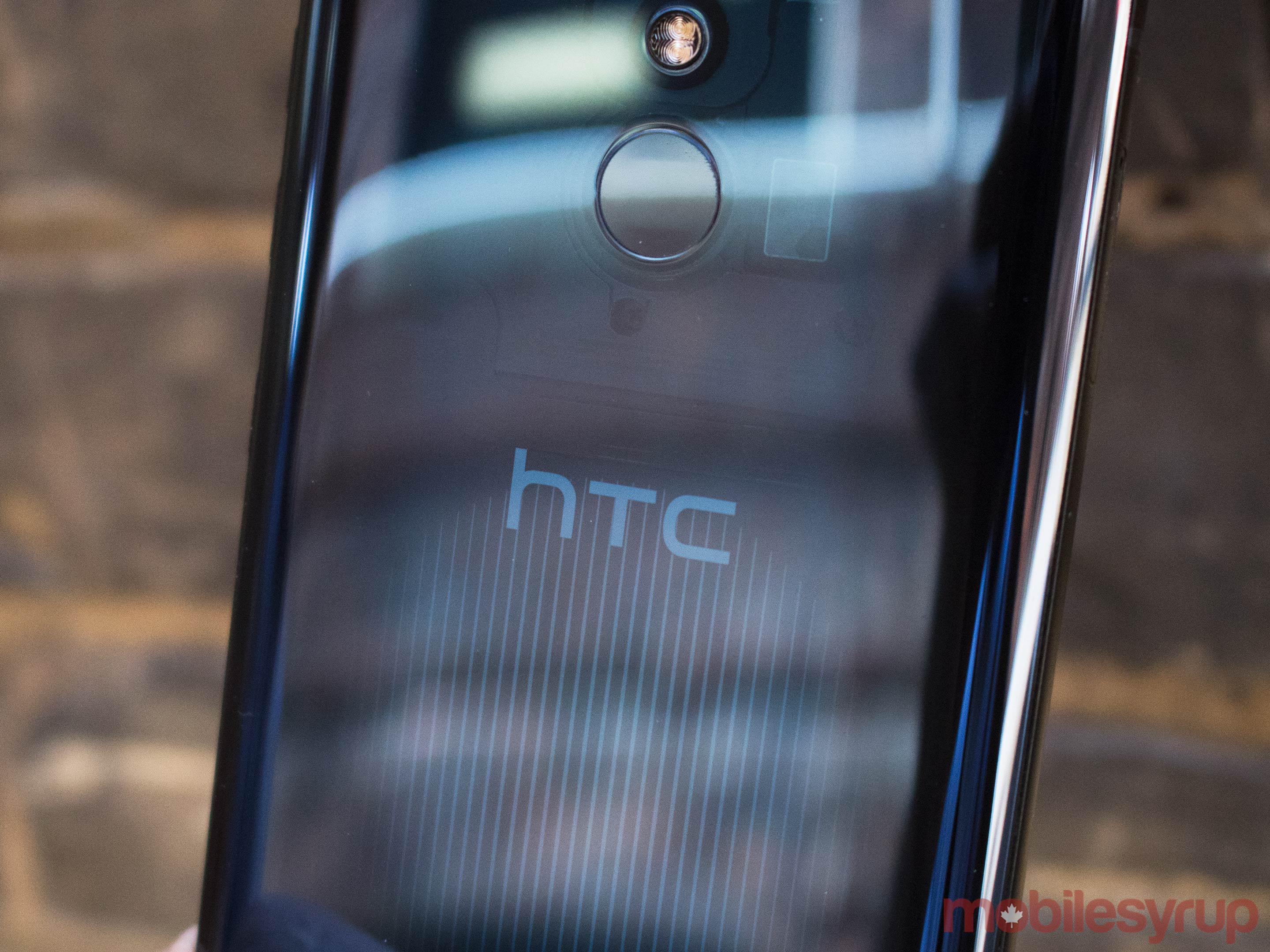
The HTC U12+ sports Android 8.0 Oreo with HTC’s Sense UI interface.
Sense UI functions similarly to stock Android with some added annoyances. HTC has added its own apps such as the messaging app and their own mail app. These apps don’t function too differently from the stock versions, but they cannot be deleted. I found the experience pretty similar to the stock Google messaging app so I didn’t mind it at all.
The phone also features the HTC Sense Companion app and Blinkfeed. Both are unnecessary, but thankfully you don’t have to use either. They aren’t annoying by any means, though. I left on Blinkfeed and used it occasionally, but I definitely felt like it wasn’t needed, especially after downloading Google News or using the Google app. In fact, Google Now would have been much more preferable to Blinkfeed.
HTC also has its ‘Theme Store’ for those who want to customize their icons and add live wallpaper.
The HTC U12+ also features its own Face Unlock functionality that works great even work in poor light conditions.
Say “four cameras”
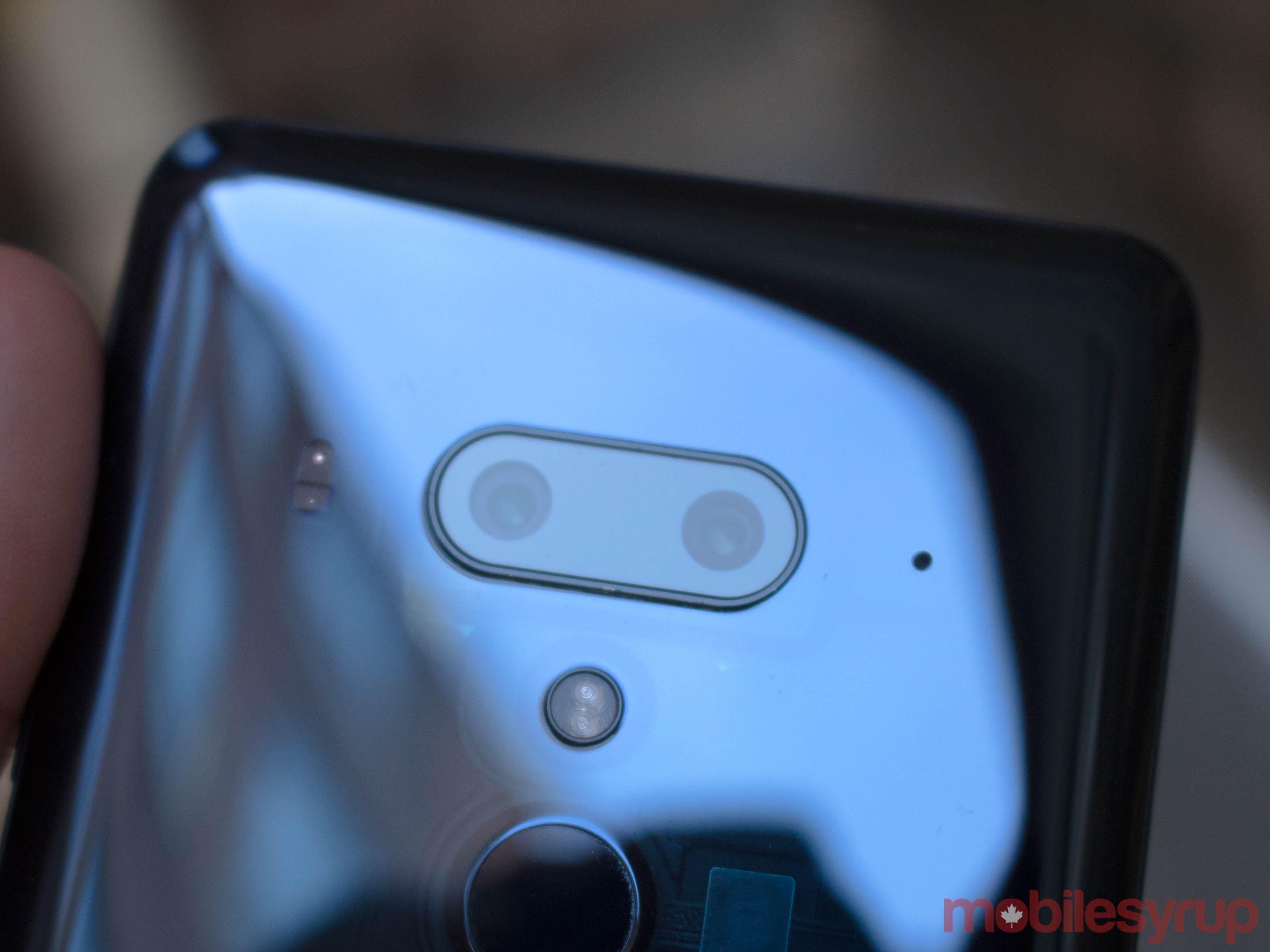
Camera-wise, the U12+’s dual front-facing shooter takes very clear selfies with a tendency toward overexposed highlights, though not to an excessive level. In the perfect lighting or in less than ideal lighting conditions, the U12+ takes detailed and clear photos.
When it’s dark, however, the selfie shooter doesn’t do quite as good of a job. Due to the phone not having a front-facing flash, those pictures don’t get too bright. There’s a screen-flash feature, however, it’s not perfect and in most situations it doesn’t provide enough light.
The dual rear-facing camera takes crisp, sharp, vivid and full of colour images. The pictures are more akin to the Samsung Galaxy S9 than the Google Pixel 2 XL, meaning colours are more saturated. Like the front-facing camera, the rear setup tends to overexpose rather than under, however, I haven’t found that it does this to an unbearable point. Users can also manually adapt the bokeh effect, allowing them to choose how blurry they want the background, this feature worked very well. Additionally, the camera features quick auto focus, something I enjoyed.
In low-light scenarios, the rear-facing camera takes blurry and grainy images. Even with the LED flash firing, pictures turned out unclear. The Huawei P20 Pro and the Galaxy S9 take far better low-light images, from my experience.
Altogether, I found the camera experience on the U12+ more favourable than the U11. It actually features a bokeh mode and colours pop more.
Battery and sound
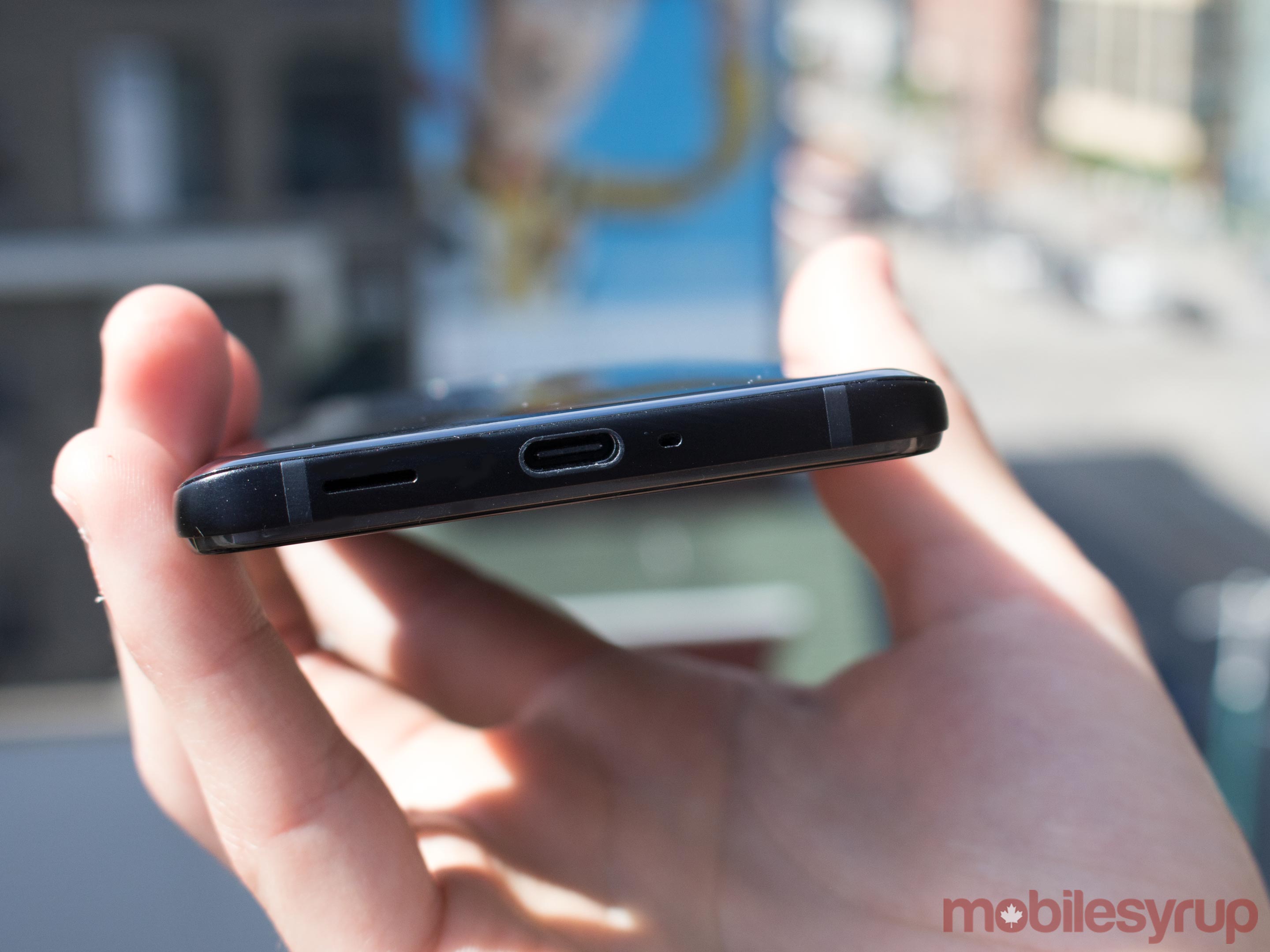
The HTC U12+ also features 3,500mAh battery, and while the phone is a powerhouse and runs smoothly, it doesn’t last long on a single charge. Someone using it with very low usage would find that it’d get them through the day. However, with medium usage, which in my case includes one hour of Netflix, 33 minutes of YouTube and about an hour-and-a-half of listening to music on Google Play Music, the phone lasted about 12.5 hours.
Meaning when my day starts at 7:00am I’ll have to charge around 7:30pm, which is frustrating. The HTC U11+ is 0.4mm thinner than the U12, but it fits a 3,900mAh battery. With such a thick phone, I expected it to have a bigger battery, or at least last me longer than 12.5 hours. With low usage, it’s possible to eek out about 19 hours of battery life.
That includes mostly searching Facebook and 20 minutes of using Twitch. Other flagship phones released this year, such as the Huawei P20 Pro, the Samsung Galaxy S9 and OnePlus 6 surpass the U12+ in terms of battery life.
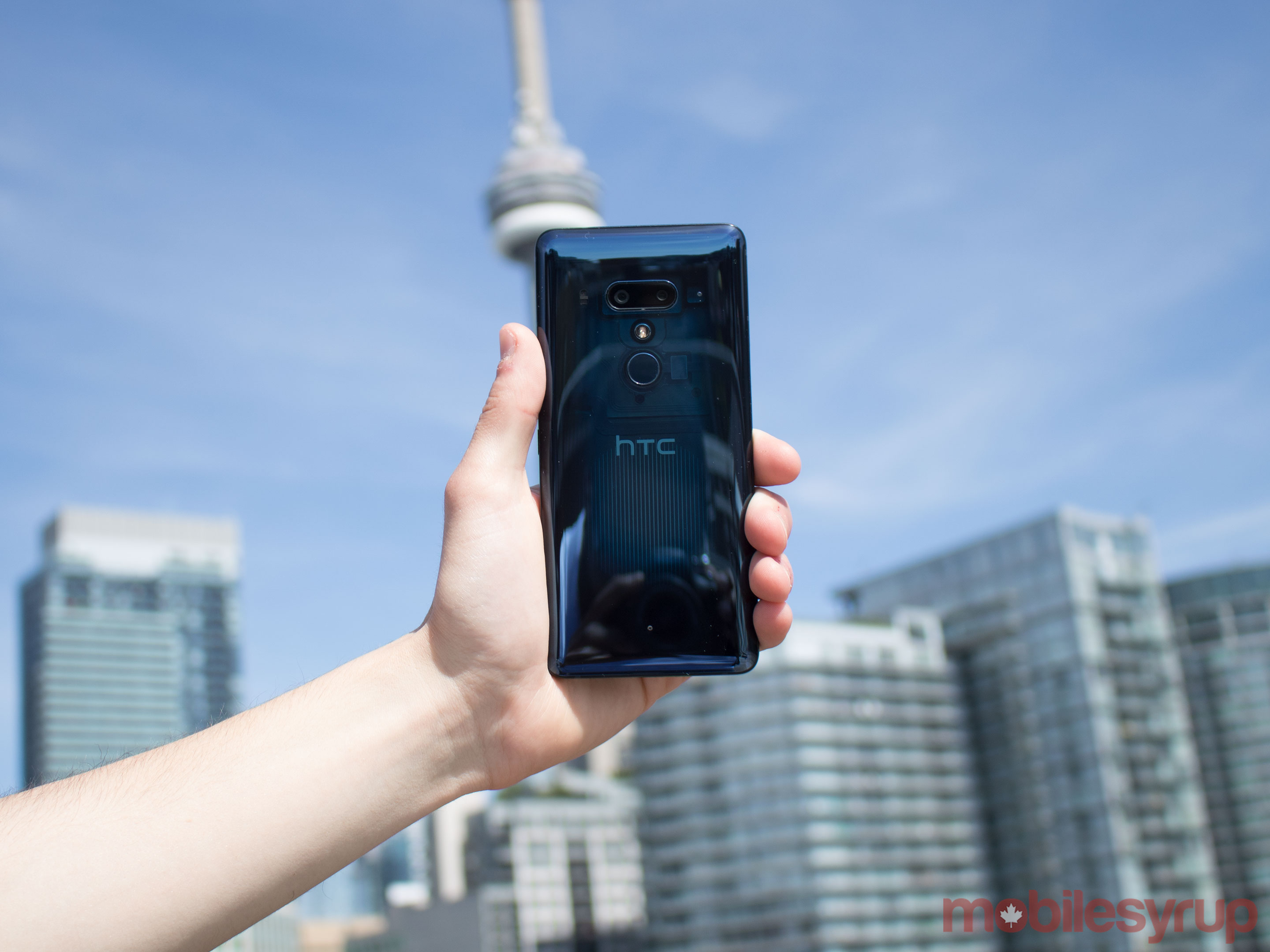
The fast charger can fully charge the device within an hour-and-a-half and get it to 50 percent in a little more than thirty minutes.
The phone’s speaker is very loud. While its volume is a little quieter than the Huawei P20 Pro and the iPhone X — measured with the Sound Meter app — when compared to the P20 Pro its sounds are richer and the bass is deeper. The phone’s volume far exceeds the Google Pixel 2 XL. For example, when Bethesda was playing a mini concert for Rage 2 during its E3 conference, I able to hear the music clearly from a different floor in my home.
The U12+ also has a feature called ‘Activity Reader’ that reads out messages, calendar events and announces who’s calling when connected to a wired or wireless headset. Users can set it so the phone doesn’t do this if the display is on, however.
Pricing and lack of availability
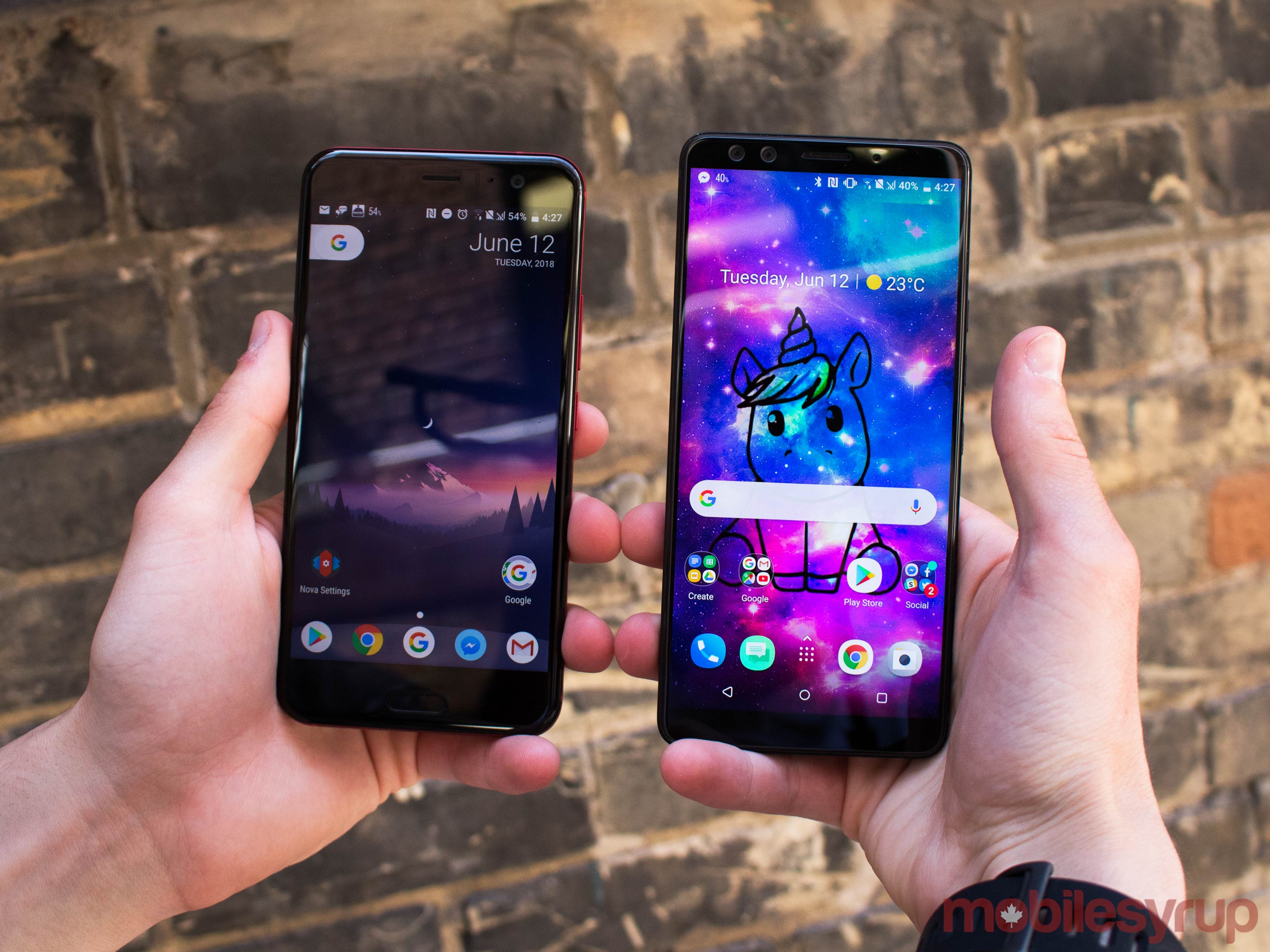
The phone is good, but definitely not great.
One of the biggest reasons is the price. The U12+ costs $1,099 (for the 64GB of storage and 6GB of RAM) and is not available at any Canadian carrier. This doesn’t compare favourably to the OnePlus 6, which retails at $699.
The unfortunate thing is the U12+ might be worth that cost if it was available at carriers on a two-year subsidy.
For those who don’t mind paying full price, though, this is definitely a good choice.
I can't say this enough, overall, I definitely enjoyed my time with the HTC U12+, but it unfortunately didn't have the greatest battery life and is pretty expensive for Canadians.
The phone feels great in the hand and the new buttons are unique. The dual camera setup takes stellar pictures and the device is such a powerhouse.
But the Huawei P20 Pro takes better pictures and feels even better in the hand, the Samsung Galaxy S9 has a better battery life and while the phone is such a powerhouse, phones like the OnePlus 6 and the S9+ also get the job done. All of three of the previously mentioned smartphones are also more affordable than the HTC U12+ for Canadians.
So while the phone is good, it won't be the 2018 smartphone king.
The phone feels great in the hand and the new buttons are unique. The dual camera setup takes stellar pictures and the phone is such a powerhouse.
MobileSyrup may earn a commission from purchases made via our links, which helps fund the journalism we provide free on our website. These links do not influence our editorial content. Support us here.


